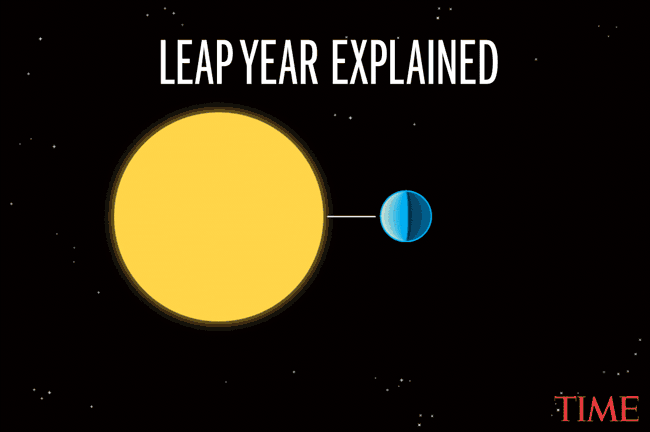
It would seem awfully hard to lose track of 0.24219 of a day. That not-inconsiderable amount adds up to five hours, 48 minutes and 20 seconds and if it were added to the clock in any 24-hour period, you’d surely notice it. But if the same span of time were spread out over the course of an entire year, it would be a whole lot easier to let it slip by.
That, in fact, is exactly what has happened virtually every year since the dawn of time. We’re accustomed to thinking of the clockwork of the solar system as a very precise thing. The moon takes a month to orbit the Earth; the Earth takes 24 hours to spin on its axis and 365 days to orbit the sun. But things are a little sloppier than that. A lunar month is actually 27.3 days. A single earthly rotation actually takes 23 hours and 56 minutes. And a single revolution takes a ragged 365.24129 days. Ever since humans began keeping calendars, that extra bit of orbital day has been a headache—and it’s the reason we came up with the concept of a leap year.

History does not precisely record which ancient culture was the first to notice the imprecision of the Earth’s orbit, but most scholars credit the Egyptians, who, around 3000 BCE, first discovered a subtle calendrical drift, with the seasons seeming to occur a day later every four years. Over the course of 120 years, that would hold things up by a full month—and that, in turn, would make a mess of critical aspects of human enterprise, most significantly agriculture, with farmers losing track of when to plant and harvest their crops.
Egypt put up with the inconvenience for close to 2,700 years, before establishing a calendar in 300 or so BCE that added an extra quarter of a day every four years. They weren’t the only culture to catch wise to the cosmic problem. In 54 BCE, Rome, under the rule of Julius Caesar, also elongated the calendar by about 6 hours every year. He later formalized things by adding an extra day to February—which was then the last month of the year—every four years. Hebrew, Chinese, and Buddhist time-keepers addressed the same matter not by adding hours to a single year, but instead adding a full month every 120 years—creating so-called interstitial or intercalary months. Parts of all three cultures have continued the practice to the present day. The Romans toyed with this idea too, creating the relatively short-lived month known as Mercedonius, inserted every two years at the end of February—though that never found wide favor and the Julian rule of adding a day to February prevailed.
Neither tacking on a year nor tacking on a month, however, was a perfect solution. Those approaches actually overcorrected a bit since the solar year is just shy of six extra hours, falling short by 11 minutes and 40 seconds. In 1582, Pope Gregory XIII stepped in to fine-tune things, establishing the eponymous Gregorian calendar. Under this new system, leap years would be skipped in the first year of every century, except those whose first two digits were evenly divisible by four. That resulted in the years 1700, 1800, and 1900 losing their leap day, but 2000 adding one. Every other fourth year in all of these centuries would get it's Feb. 29. And with that the calendrical second hand was accurately adjusted.
Millennia later, being born on leap day—Feb. 29—has a certain cachet, with any one person having a one in 1,461 chance of celebrating a birthday on that day. That comes out to just 5.4 million people worldwide. There is a certain unhandiness to that distinction too. Three out of four years, leap year babies have to decide whether to celebrate their birthdays on Feb. 28 or Mar. 1. The light opera The Pirates of Penzance turns on that device, with a young man who was born on Feb. 29 and apprenticed to pirates until he was 21 believing he was free of his obligations when he reached that age—only to learn that the terms of his apprenticeship kept him bound until his twenty-first birthday, an occasion that would not arrive until he was 84.
But our calendar does not play out onstage or at birthday parties. It plays out in space, in our planet’s slow and dignified procession around the sun. The flywheels of the solar system are indeed precise things; it is humans, with their rough sense of timekeeping, who brought the imprecision to the table. Leap years are our solution to setting the clock to rights.
More Must-Reads From TIME
- The 100 Most Influential People of 2024
- How Far Trump Would Go
- Scenes From Pro-Palestinian Encampments Across U.S. Universities
- Saving Seconds Is Better Than Hours
- Why Your Breakfast Should Start with a Vegetable
- 6 Compliments That Land Every Time
- Welcome to the Golden Age of Ryan Gosling
- Want Weekly Recs on What to Watch, Read, and More? Sign Up for Worth Your Time
Write to Jeffrey Kluger at jeffrey.kluger@time.com